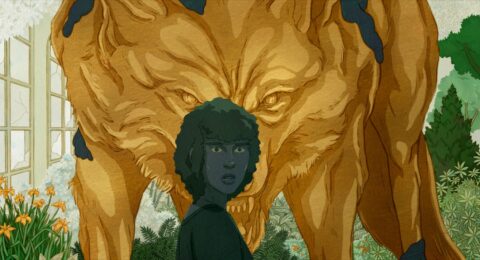Death actually does exist, but perhaps it’s better to pretend like it doesn’t. Only that way might we actually have the courage to change the world.
So argues Québécois director Félix Dufour-Laperrière in his maddeningly vague animated film Death Does Not Exist (2025), which, although technically accomplished and often visually compelling, feels lost behind activist and progressive philosophical clichés that never add up to anything truly politically potent. Blending an eco-thriller with a surrealist, Ghibli-esque aesthetic, Laperrière’s weak vision is less Princess Mononoke (Hayao Miyazaki, 1997) and more Tales from Earthsea (Goro Miyazaki, 2006).
It starts with a montage of animal and human statues in a large botanical garden, with old folks (looking rather statuesque themselves) strolling around, before the camera pans out, revealing a large gated community. It is a place that Hélène (Zeneb Blanchet) and her buddies, including her lover Marc (Mattis Savard-Verhoeven), plan to invade, for… reasons…
The problem with the noble aims of our heroes is that their enemies are extremely ill-defined. They don’t seem to be that bad at all, only that they own a lot of property. So it certainly doesn’t really imbue with us with much sympathy for the leftists when they storm the property and shoot people. It especially doesn’t make us feel conflicted about Hélène, who wisely doesn’t join in and flees into the forest, where she is pursued by the ghost-like apparition of her dead co-conspirator Manon (Karelle Tremblay).
We remain in the forest for the majority of the rest of the film, which is mostly about Hélène’s moral crisis with a few wolf-eating-sheep and statue metaphors mixed in. This might have been a great opportunity for the film to actually invest us in the stakes of the film — as Ghibli’s best work does — but instead it remains infuriatingly unclear as to why we should care about Hélène getting back and fighting the rich at all. In fact, it gets so generically cringey, I half-expected Kendall Jenner to turn up with a Pepsi can.
Still, if you are willing to disregard plot, character and theme, the animation style is compelling all by itself, with the hand-drawn landscapes feeling like they have stumbled directly out of a Hokusai painting (the closest film comparison might be Isao Takahata’s The Tale Of Princess Kaguya [2013]). Particularly interesting is the way that the characters’ faces change colour depending on the landscape around them, as well as a neat technique where the camera might zoom in while the animation pushes rapidly towards us. It’s just a shame that such talent in image-making is wasted by such a painful script. Perhaps best enjoyed with the sound (and subtitles) off.
Redmond is the editor-in-chief of Journey Into Cinema.

